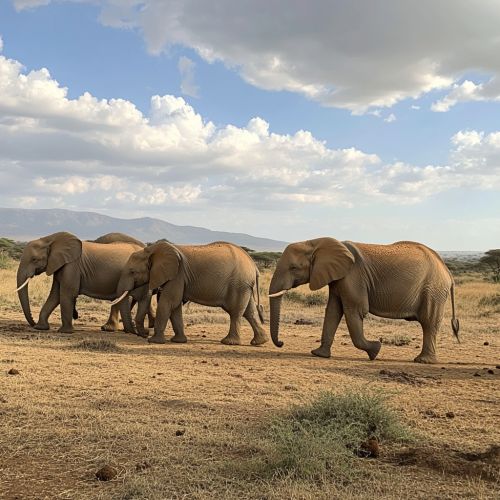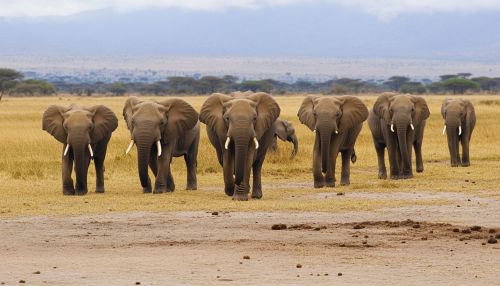Tsavo East National Park
Overview
Tsavo East National Park is one of the oldest and largest national parks in Kenya, situated in the southeastern part of the country. Established in 1948, the park covers an area of approximately 13,747 square kilometers. It is renowned for its vast landscapes, diverse ecosystems, and rich biodiversity. The park is part of the larger Tsavo Conservation Area, which also includes Tsavo West National Park and several adjacent wildlife sanctuaries.
Geography and Climate
Tsavo East National Park is characterized by semi-arid conditions, with a landscape dominated by open savannah, scrublands, and scattered acacia trees. The park is bisected by the Galana River, which provides a vital water source for the wildlife. The Yatta Plateau, one of the world's longest lava flows, stretches along the western boundary of the park.
The climate in Tsavo East is generally hot and dry, with temperatures ranging from 20°C to 40°C. The region experiences two rainy seasons: the long rains from March to May and the short rains from October to December. The annual rainfall varies between 300 mm and 700 mm, with the northern part of the park receiving less precipitation than the southern part.
Flora and Fauna
Tsavo East National Park is home to a wide variety of plant and animal species. The vegetation is predominantly composed of savannah grasslands, thorny bushes, and baobab trees. The park also features riverine forests along the Galana River and seasonal wetlands that support diverse plant life.
Mammals
The park is famous for its large populations of African elephants, often referred to as the "red elephants" due to the reddish-brown color they acquire from the park's soil. Other notable mammal species include lions, leopards, cheetahs, buffaloes, giraffes, zebras, and various antelope species such as the lesser kudu, gerenuk, and oryx.
Birds
Tsavo East is a birdwatcher's paradise, with over 500 recorded bird species. Some of the notable avian species include the African fish eagle, martial eagle, secretary bird, ostrich, and various species of hornbills, weavers, and sunbirds. The park's diverse habitats provide ideal conditions for both resident and migratory birds.


Conservation Efforts
Tsavo East National Park plays a crucial role in wildlife conservation in Kenya. The park is managed by the Kenya Wildlife Service (KWS), which implements various conservation programs to protect the park's biodiversity. Key conservation initiatives include anti-poaching patrols, habitat restoration, and community outreach programs to promote sustainable land use practices.
The park is also part of the larger Tsavo Conservation Area, which facilitates coordinated conservation efforts across multiple protected areas. Collaborative projects with international conservation organizations aim to address challenges such as human-wildlife conflict, habitat fragmentation, and climate change impacts.
Tourism and Activities
Tsavo East National Park is a popular destination for tourists seeking an authentic African safari experience. The park offers a range of activities, including game drives, bird watching, and guided nature walks. The park's vast landscapes and diverse wildlife provide ample opportunities for photography and wildlife observation.
Main Attractions
- **Mudanda Rock**: A natural rock formation that serves as a water catchment area, attracting large numbers of elephants and other wildlife. - **Aruba Dam**: A man-made reservoir that provides a vital water source for the park's animals, particularly during the dry season. - **Lugard Falls**: A series of rapids and waterfalls on the Galana River, named after Frederick Lugard, a British colonial administrator.
Challenges and Future Prospects
Despite its significance, Tsavo East National Park faces several challenges that threaten its ecological integrity. Poaching, particularly of elephants and rhinos, remains a major concern. Habitat degradation due to human activities such as agriculture and livestock grazing also poses a threat to the park's ecosystems.
Efforts to address these challenges include strengthening law enforcement, promoting community-based conservation initiatives, and enhancing ecological monitoring. The future of Tsavo East National Park depends on the continued commitment to conservation and sustainable management practices.
